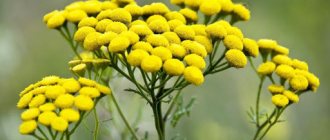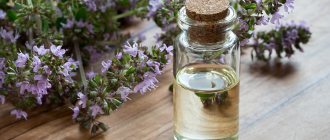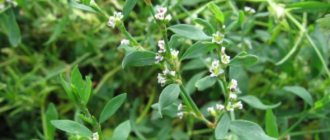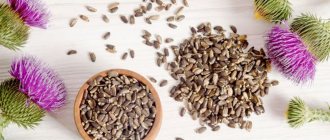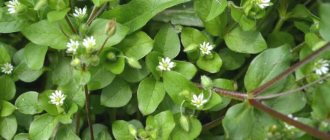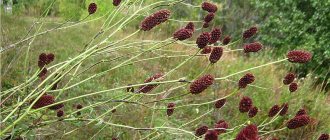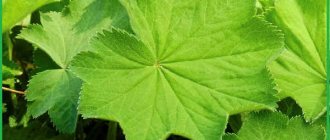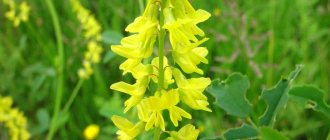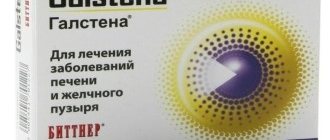Greater celandine (yellow euphorbia, warthog,
warthog, yellow milkweed, cleanweed) -CHELIDONIUM MAJUS L.
Sem. poppy - Papaveraceae
DESCRIPTION. A perennial herbaceous plant 30-80 cm high, with a short rhizome and a taproot, branched root. The root is red-brown on the outside, yellow on the inside. The stem is branched, sparsely pubescent. Leaves are alternate; basal and lower stem ones are on long petioles, the upper ones are sessile. The leaf blade is deeply imparipinnate, with large, sinuous lobes; the middle lobe is three-lobed, larger than the others; The leaves are green above, bluish below. The flowers are bright yellow, collected in groups of 3-8 at the ends of the stems in simple umbrella-shaped inflorescences. A calyx of two sepals that usually fall off when the flower opens. The corolla is regular and has 4 obovate petals. There are many stamens, the pistil has a short thick style and a small two-lobed stigma. The fruit is a pod-shaped capsule, opening with two flaps from the base to the apex. The seeds are black, shiny, with a white comb-like appendage. The entire plant contains an orange milky sap. Blooms from May to September; the fruits begin to ripen in June.
RAW MATERIALS. The medicinal raw material is the above-ground part of the plant (Herba Chelidonii), collected during the flowering period. Dried raw materials consist of grass with flowers and fruits, collected at different stages of their development. The leaves are thin, the flowers are bright yellow, four-petaled; fruits are pod-shaped, multi-seeded capsules up to 5 mm long. The smell of the plant is pungent, the taste is bitter and pungent.
DISTRIBUTION AND PROCESSING. Distributed everywhere. It grows in gardens, vegetable gardens, garbage areas, near homes and in pastures as a weed plant.
During the flowering phase, grass is cut at a distance of 5-10 cm from the ground surface. Dry outdoors or in well-ventilated areas.
When working with the plant, with all its parts, it is recommended to wear tarpaulin gloves and a damp gauze bandage on the face to avoid burns from the juice and dust of celandine, which strongly irritate the nasal mucosa. Shelf life - up to 3 years.
CHEMICAL COMPOSITION. All parts of greater celandine contain alkaloids close to opium. They are represented by four groups. Alkaloids of the first group are naphthophenanthredine derivatives: chelidonine, homochelidonine, chelerythrine, methoxychelidonine, oxychelidonine, sanguinarine, oxysanguinarine, chelirubine, helilutin. Alkaloids of the protopine group are represented mainly by allocryptopine. Alkaloids of the diisoquinoline group are represented by berberine, coptisine, sparteine and some poorly studied bases.
The highest content of alkaloids in the grass is observed during the flowering period, when their total is 1.87%. In the roots, the content of alkaloids ranges from 1.90 to 4.14%, vitamins A and C are present. Chelidonine acts like syphorin, inhibiting and then causing paralysis of the central nervous system. Homogelidonin is a convulsive poison, a strong anesthetic, and has a local effect. Sangrinorine has a narcotic effect, stimulates intestinal motility and salivary secretion.
In addition to alkaloids, celandine grass contains carotene, ascorbic acid, organic acids (chelidonic, chelidonic, malic, citric, succinic), saponins and flavonoids. The seeds contain 40-60% fatty oil, and the milky juice contains resinous substances.
APPLICATION. Pharmacological studies have established that preparations of greater celandine have a fungistatic and bacteriostatic effect in relation to the tuberculosis bacillus and cause a delay in the growth of malignant tumors. Therefore, for a long time, fresh plant juice and herbal infusion have been used for a wide variety of skin diseases: for cauterization of warts and condylomas, for the treatment of difficult-to-heal wounds and lupus erythematosus.
In addition, celandine preparations are used internally for diseases of the liver, gall bladder and as a painkiller for stomach ulcers. The pharmacological activity of a number of celandine alkaloids has been studied. Sanguinarine is recommended as an anti-inflammatory agent for stomatitis and gingivitis. The use of celandine herb as an anti-inflammatory agent is allowed. Celandine roots are used in homeopathy.
In folk medicine, celandine milk juice is used as a painkiller for diseases of the liver and gall bladder (gallstones, sand, jaundice), stomach catarrh, diarrhea, and indigestion. It is also recommended to use fresh juice, water infusions, and alcohol tinctures prepared from fresh raw materials for medicinal purposes.
RECIPES
Ointment
or
fresh juice
is used to remove warts, calluses, treat lichen, scabies, skin cancer, skin tuberculosis. The ointment is prepared as follows: a) fresh celandine juice should be mixed with petroleum jelly in a ratio of 1:4; b) mix the powder with petroleum jelly (1:1) and add 0.20% carbolic acid (mold prevention).
In Bulgarian folk medicine, celandine (in the form of a decoction) is used as a diuretic for dropsy, scrofula, syphilis, malaria, jaundice, and to regulate menstruation. The milky juice of the fresh plant is successfully used to remove warts. The ointment is prepared as follows: the dried herb is crushed into powder, sifted through a sieve and mixed with petroleum jelly and lanolin in equal proportions.
Infusion:
1 hour Pour 2 cups of boiling water over a spoonful of herbs and roots, leave for 30 minutes, strain. Take 1/2 cup 4 times a day as a choleretic.
External:
4 tbsp. Boil tablespoons of chopped herbs with flowers for 5 minutes in 6 glasses of water in a sealed container, leave for 8 hours, strain. Use for baths and washes for scrofula and skin diseases.
Celandine grass crushed raw material 50g
Name
Celandine grass modified raw material 50g per pack
Main active ingredient
Celandine grass
Indications for use
Externally: as part of complex therapy for skin diseases (dermatitis, psoriasis, eczema). Use for these purposes is based only on experience of long-term use.
Directions for use and doses
About 20 g (6 tablespoons) of raw materials are placed in an enamel or other suitable container, filled with 200 ml (1 glass) of water at room temperature, covered with a lid, and heated in boiling water (water bath) for 15 minutes. Cool at room temperature for 45 minutes, filter. The remaining raw materials are squeezed out. The volume of the resulting infusion is adjusted to 200 ml with boiled water. Externally used for baths (1-2 glasses of infusion per bath), in the form of lotions (without dilution). It is recommended to shake the infusion before use. The duration of the course of treatment is determined by the doctor, taking into account the characteristics of the disease, the achieved effect and tolerability of the drug.
Use during pregnancy and lactation
About 20 g (6 tablespoons) of raw materials are placed in an enamel or other suitable container, filled with 200 ml (1 glass) of water at room temperature, covered with a lid, and heated in boiling water (water bath) for 15 minutes. Cool at room temperature for 45 minutes, filter. The remaining raw materials are squeezed out. The volume of the resulting infusion is adjusted to 200 ml with boiled water. Externally used for baths (1-2 glasses of infusion per bath), in the form of lotions (without dilution). It is recommended to shake the infusion before use. The duration of the course of treatment is determined by the doctor, taking into account the characteristics of the disease, the achieved effect and tolerability of the drug.
Precautionary measures
Consult your physician before use. Treatment is carried out under the supervision of a doctor. If symptoms persist or worsen during treatment, you should stop using the drug and consult a doctor.
Interaction with other drugs
Information is absent. In case of simultaneous use of other drugs, you should consult your doctor.
Contraindications
Hypersensitivity to biologically active substances of the drug, pregnancy, lactation, children under 18 years of age.
Compound
Celandine herb contains alkaloids: isoquinoline derivatives (chelidonine, chelerythrine, sanguinarine, etc.), protoberberine alkaloids (berberine, coptisine), etc.; essential oil, carotenoids, flavonoids (rutin, kaempferol, quercetin), saponins, ascorbic acid, organic acids - malic, citric and succinic.
Overdose
There is no information on cases of overdose with external use. When taken orally, nausea, vomiting, abdominal pain, diarrhea, jaundice, liver disorders (increased blood levels of bilirubin and liver enzymes, including cases of toxic hepatitis and liver failure) may develop. If these symptoms occur, you should consult a doctor. Treatment is symptomatic.
Side effect
Allergic reactions are possible (including hyperemia, itching and skin rashes). If any adverse reactions occur, including those not listed in this instruction, you should stop using the drug and consult a doctor.
Storage conditions
Information is absent. In case of simultaneous use of other drugs, you should consult your doctor.
Buy Celandine herb modified raw materials 50g per pack in the pharmacy
Price for Celandine herb modified raw materials 50g per pack
Instructions for use for Celandine herb modified raw materials 50g in a pack
Traditional medicine: Wiki: Celandine
- Celandine (1)
- Chemical composition of celandine (1.1)
- Useful properties of celandine and its use (1.2)
- How to prepare juice, tincture and decoction of celandine? (1.3)
- Celandine tincture (1.3.1)
- Celandine juice (1.3.2)
- Celandine decoction (1.3.3)
- Celandine for skin diseases (1.4.1)
- Psoriasis (1.4.1.1)
- Warts and papillomas (1.4.1.2)
- Pimples and acne (1.4.1.3)
- Eczema (lichen) (1.4.1.4)
- Dermatitis (1.4.1.5)
- Warts (1.4.1.6)
- General treatment recommendation (1.5.1)
The celandine plant belongs to the poppy family and the dicotyledonous genus.
It is a tall perennial herbaceous shrub with a hollow stem and lyre-shaped dark green leaves. Celandine blooms with yellow flowers, and then in their place small pods ripen, which crack in two and throw out seeds. The plant bears fruit 2-3 times during the summer, so it reproduces effectively and is found almost everywhere. Science knows two types of celandine:
- Chelidonium asiaticum – Asian (30-50 cm tall);
- Chelidonium majus – large (50-120 cm tall).
Both types of plants are poisonous, but have a number of beneficial properties, so they have long been actively used in both Eastern and European folk medicine. The Russian-language name of this herb speaks for itself - it “cleanses the body” of warts, pimples and non-healing wounds. And the Latin name has a beautiful origin story: in the time of Avicenna it was believed that swallows treated the festering and blind eyes of their chicks with the bitter juice of celandine. Hence the term Chelidonium (literally “swallow”). In ancient Rus', celandine had numerous characteristic nicknames: yellow milkweed, podtynnik, warthog, chistukha, dog soap.
Chemical composition of celandine
The leaves, stems, rhizomes and bitter milk of celandine contain:
- Ascorbic acid (vitamin C) and carotene (vitamin A);
- Organic acids (malic, citric, succinic);
- Essential oils, bitters, resins and saponins;
- Natural antibiotics (phytoncides);
- Poisonous alkaloids (chelidonine, sanguinarine, protopine, alocryptopine, coptisine).
Chelidonine and its derivatives deserve special attention: oxychelidonine, homochelidonine and methoxychelidonine. This alkaloid is a direct relative of morphine, which is not surprising, since celandine is a relative of poppy. Chelidonine in small doses has an analgesic effect, but in large doses it causes convulsions and paralysis of the nervous system. The highest content of alkaloids is in the rhizomes of celandine (up to 0.5%), however, the leaves of the plant are also poisonous, so livestock on pastures avoid it.
Useful properties of celandine and its use
With proper skill and care, celandine can be used to cure many diseases.
Thanks to its complex and rich biologically active composition, celandine has a multifaceted effect on the human body:
- Anesthetic;
- Antitumor;
- Bactericidal;
- Antifungal;
- Wound healing;
- Antispasmodic;
- Bile and diuretic;
- Expectorant.
Celandine is used to treat diseases:
- Skin
– psoriasis, scabies, acne, warts and papillomas, mycoses, eczema, burns, wounds and ulcers;
- ENT organs and respiratory system
– runny nose, bronchitis, tracheitis, laryngitis, sore throat, pneumonia, asthma, whooping cough, tuberculosis;
- Gastrointestinal tract
– gastritis, stomach ulcer, pancreatitis, cholecystitis, hepatitis, enterocolitis;
- Joints and bones
– rheumatism, radiculitis, gout, osteochondrosis, arthritis and arthrosis;
- Nervous system
– headaches, migraines, neuroses;
- Female genital organs
– vaginitis, colpitis, cervicitis, endometriosis, cervical erosion.
In addition, celandine is used to relieve pain (dental, menstrual, joint) and inhibit the development of malignant tumors. The anti-carcinogenic properties of this poisonous plant are now being actively studied, since it has been found that celandine tincture prevents the appearance of metastases.
In animals, it initially causes a state of depression, and after it comes complete paralysis of the nervous system. An overdose can lead to very severe cramps, so strictly follow the dosage.
Sanguinarine can have a similar effect. Only it is still able to increase the activity of the intestines and increases the secretion of saliva, and can also have a local analgesic effect. As numerous studies have shown, celandine’s most basic properties are antispasmodic, choleretic and anti-inflammatory.
How to prepare juice, tincture and decoction of celandine?
Celandine tincture
The medicine can be purchased in ready-made form, but since celandine grows almost everywhere, it is not worth spending money. Go for the herb in early summer, when the plant first blooms and the leaves are still fresh and fleshy. Wash them thoroughly, chop them finely and fill a liter jar to the top with raw materials, then fill them with 70% medical alcohol and leave in a dark, dry place for 2 weeks. In addition, if you can infuse celandine tincture for 5-6 months, you will receive an even more concentrated and highly effective medicine.
It is better to treat serious diseases, especially cancer, with the help of alcohol tincture, since in ordinary decoctions and water infusions the concentration of alkaloids is an order of magnitude lower. In addition, alcohol tincture can be stored for a long time and consumed economically. By waiting six months, you will receive high-quality and effective medicine with virtually no investment.
You should start treatment with celandine tincture only when the expected benefit is greater than the possible risk. Remember that this is essentially a potent plant poison that you need to gradually get used to. For the first 3-4 weeks, the tincture is taken 5-10 drops per day, and then every week the dosage is increased by 10 drops, and so on up to 50. The duration of treatment depends on the type of disease: for example, for cancer and tuberculosis, celandine tincture is taken for at least six months.
You can prepare celandine tinctures not only alcohol-based, but also water-based:
- Water infusion.
To prepare a water-based decoction of celandine, you need 1 tablespoon of dry celandine herb and 1 glass of boiling water. The herb should be poured with a glass of boiling water, then covered and left to steep for 30–40 minutes. Next, the infusion must be strained and taken chilled, 2/3 cup 15 minutes before meals. This tincture is used to normalize liver function.
Celandine juice
In folk medicine, there are 2 ways to prepare celandine juice:
- The first method: from fresh, just collected celandine stems up to 15 cm long, along with flowers, it is quite possible to prepare the juice of this herb for the winter. To prepare juice for the winter from celandine raw materials, the leaves must be passed through a meat grinder and then thoroughly squeezed. The resulting juice should be placed in the refrigerator for three days, and then the juice should be strained through cheesecloth, poured into a clean container and covered with a lid that has small holes so that gas does not accumulate in the jar during the fermentation process of the juice. After three weeks, the fermentation process of the juice in the jar will end and the finished celandine juice will be able to stand in the refrigerator until the next “harvest” of the herb.
- Second way Celandine juice can be prepared as follows: you need to carefully cut the grass stems 12–15 cm long along with the flowers, then pass them through a meat grinder and squeeze out the juice, as in the first method. Then you should add alcohol or vodka at the rate of 500 g of vodka or 250 g of alcohol per 1 liter of juice.
Celandine juice, as has already become clear, is very useful: it can cure approximately 250 skin and other diseases, for example, herpes, burns, pimples, acne, lupus, fungus, fistulas, scabies, peeling, condylomas, polyps, etc.
Celandine decoction
To prepare a decoction of celandine, you need fresh or pre-dried raw materials (sold in a pharmacy).
Pour 1 teaspoon of dry raw material with a glass of boiling water, let it brew for 15 minutes, then strain. The decoction is good for diseases of the liver, gall bladder, duodenum, as well as for diseases of the bladder. Take 1/3 cup 3 times a day. The course of treatment is 5-7 days.
Find out more: Kvass on celandine according to Bolotov
Treatment with celandine
Celandine is successfully used to combat initial forms of skin tuberculosis, true adenomatous polyps of the large intestine, cervical erosion, intestinal and laryngeal papillomatosis. Also, eczema, lichen and acne respond very well to treatment with celandine; in addition, celandine promotes the healing of purulent ulcers and wounds.
In homeopathy, celandine is very often used for liver diseases that are difficult to diagnose and recognize, and they have the following symptoms: poor health in damp weather, while in a warm room it suddenly becomes better, the appearance of a sharp feeling of disgust for cold drinks and meat , craving for hot coffee. In rare cases, homeopaths themselves prescribe celandine for diseases such as pneumonia, pleurisy, gout, headaches accompanied by dizziness and general weakness, stomach and liver cancer.
Celandine for skin diseases
Psoriasis
If the lesion is small, it should be lubricated with freshly squeezed celandine milk in the morning and evening for 10-14 days.
If psoriasis has affected large areas of the skin, take baths for the same period: for every 3 liters of boiling water, take 25 grams of chopped herbs, brew and wait until the infusion cools to a comfortable temperature.
The most powerful remedy for psoriasis is a decoction of celandine roots. They are first kept in hot water for 2 hours until softened, and then boiled for half an hour, cooled, filtered and made into lotions from sterile gauze for 2-3 hours.
Warts and papillomas
These unsightly blemishes appear on the skin under the influence of the human papillomavirus. You can cauterize and remove a wart using fresh celandine juice, as our ancestors did in ancient times. The skin around the papilloma or wart is protected with baby cream, and juice is applied to the neoplasm itself every 2-3 hours every day until the wart is completely dry and the surface is healed.
Fresh celandine juice mixed in equal parts with alcohol tincture of propolis, which can be purchased at a pharmacy, also helps. The method of application is similar.
Local treatment of papillomas and warts with celandine is best combined with a decoction or infusion:
- Alcohol infusion
It takes 2 weeks to prepare from half a liter of alcohol and 2 tbsp. spoons of dried celandine; take it 10-15 drops before meals for a month.
- Decoction
done like this: 2 tbsp. spoons of fresh celandine pour two glasses of cold water, boil, leave for 2 hours, then put in the refrigerator and take 1 tbsp. spoon before eating.
Pimples and blackheads
If you have dry and sensitive skin, the best way to get rid of acne is with lotion. To prepare it, take 2 tbsp. spoons of dried celandine, pour 0.5 liters of boiling water, let it brew for 3 hours, strain thoroughly and put it in the refrigerator. In the morning and evening, wipe your face with a cotton pad soaked in lotion for at least 10 minutes in a row.
Also a good recipe for dry skin is celandine ointment. You can make it yourself from cosmetic Vaseline and freshly squeezed plant juice in proportions of 5/1. Store the ointment in the refrigerator and lubricate the face at night for at least two weeks in a row.
An alcohol lotion is used to treat acne on oily skin. To prepare it, take the juice of one cucumber, 100 ml of alcohol and 50 ml of freshly squeezed celandine juice. All components are mixed and left in the refrigerator for 10 days, and then rubbed with this lotion on oily skin in the mornings and evenings.
For any skin type, it is important to treat acne and blackheads with celandine using cosmetic masks. They need to be done 2-3 times a week. Take the yolk of one egg, a teaspoon of celandine juice and a teaspoon of olive oil, mix everything and apply to your face for 10-15 minutes.
Eczema (lichen)
Take 20 g of dry crushed celandine herb raw material, pour it into an enamel bowl, pour in a glass of water (boiling water), then cover everything with a lid and heat it in a water bath for about 15 minutes, then cool it at room temperature for 45 minutes. Next, the broth should be filtered and poured into a glass container with a good stopper. The shelf life of the decoction is no more than two days. The resulting decoction of celandine should be lubricated on diseased areas of the body.
Take 10 g of dry crushed celandine raw material and the same amount of dandelion raw material, everything is placed in an enamel bowl. Dry crushed herbs must be poured with a glass of boiling water, after which everything is covered with a lid and boiled for 30 minutes in a water bath. Next, the broth should be cooled at room temperature for about 15 minutes. Afterwards, the product must be strained, carefully squeeze out the raw materials and pour the broth into a glass container with a good, tight stopper. The shelf life of this decoction is no more than two days; it must be stored in a cool place. This decoction also needs to be moistened on diseased areas of the body.
Dermatitis
Quite often, an infusion of celandine herb is used to treat various types of itchy skin diseases that are in the stage of a severe inflammatory process.
Most often used for treatment are baths filled with infusion of celandine. You need to take 10 g of celandine raw material per 100 ml of boiling water, brew it, then everything is cooled to 37 ° C, baths are used daily, lasting 15–20 minutes. After 2–3 days of such treatment, the result becomes visible: itching decreases, hyperemia decreases, swelling goes away, and the scratched surface of the skin heals. To eliminate dandruff, you need to rub an infusion of celandine herb into the hair roots.
Warts
To remove warts, condylomas, polyps, calluses, you need fresh milky juice and extract, which must be diluted in glycerin. The same composition is used to treat skin cancer - there are cases when this led to a complete recovery of patients.
You can remove warts in the following way. The wart must be slightly moistened with water, then the top layer must be scraped off a little (a sterile cutting instrument is required, but ordinary pumice stone can also do the job), after which the wart must be rubbed 2-3 times during the day with fresh celandine juice, which is abundantly released from the cut of the root or aerial part plants.
Treatment of gynecological diseases with celandine
Celandine is used for the following gynecological diseases:
- Thrush.
For oral administration, prepare a decoction of 1 glass of water and 1 tbsp. spoons of chopped celandine. Boil for 10 minutes, cool, filter and divide into 2 doses during the day. Treatment is continued for 14 days. All this time you need to douche and take baths with celandine. For 3 liters of boiling water, take 3 tablespoons of chopped grass, steam it, cool it and sit in a basin for 10-15 minutes.
- Climax.
Take 2 parts each of chamomile and yarrow herb, as well as 1 part each of bloodroot and fresh celandine. Prepare an infusion of these herbs (1 tablespoon of the mixture per 1 glass of water), divide into three doses and drink every day for a month. The tides and mood swings will stop.
- Endometritis.
Pour 1 tablespoon of fresh celandine leaves into a glass of boiling water, wait two hours, strain, divide into three doses and drink throughout the day. Endometritis must be treated in this way for at least 20 days for a pronounced anti-inflammatory effect to occur.
- Cervical erosion.
For three liters of boiling water, take 2-3 tablespoons of crushed celandine, steam the herb in a basin and wait until it cools to room temperature. Take sitz baths for 15-30 minutes every day for 10 days in a row.
- Uterine fibroids and ovarian cyst.
Neoplasms in the female reproductive organs are best treated in the same way as oncology - with the help of an alcohol tincture of celandine, the recipe for its preparation and recommendations for use are described above.
Celandine for men's problems
Celandine is used for the following diseases:
- Haemorrhoids.
This disease most often affects men who lead a sedentary lifestyle or spend a lot of time driving. Treatment of hemorrhoids with celandine is carried out using enemas. You need to take celandine herb at the rate of half a gram per 1 kg of the patient’s weight, pour it with 10 times the volume of hot water, and leave for 2 hours. During this time, the solution will cool to approximately body temperature. The patient is placed on his right side and the medicine is injected into the rectum using a bulb. You should try to do this for a couple of hours. Enemas with celandine not only heal well, but also relieve pain from hemorrhoids.
- BPH.
To stop an acute inflammatory process, you need to dilute 2 teaspoons of celandine juice in half a glass of water every day for a week and drink this solution at any convenient time. Treatment of prostate adenoma with celandine will be more effective if you supplement it with herbal enemas with chamomile, sage and 1 tablespoon of celandine juice.
Treatment of celandine diseases of the gastrointestinal tract
Celandine is used for the following gastrointestinal diseases:
- Cholecystitis.
Alcohol tincture of celandine, prepared independently according to our recipe or purchased at a pharmacy, for cholecystitis and cholelithiasis, take 10 drops per day for two weeks, while following a strict diet prescribed by a doctor.
- Cirrhosis of the liver.
For 2 parts of dried celandine, take 1 part each of yarrow, adonis and horsetail. Twice a day, prepare an infusion of a glass of boiling water and two teaspoons of this mixture, leave it for 15-20 minutes and drink completely before meals. You can also take fresh celandine juice, a teaspoon three times a day, but there may be side effects, although the effectiveness will be higher.
- Hepatitis.
Take one part each of dried celandine and calamus rhizomes. An infusion is prepared from two teaspoons of this mixture and a glass of boiling water for 60 minutes, then divided into 6 parts and taken throughout the day. The course of treatment for hepatitis with celandine is 2-3 weeks.
A decoction of the following ingredients also helps:
Dried celandine – 3 parts;
- Dandelion root – 1 part;
- Anise fruits – 2 parts;
- Corn silk – 2 parts;
- Cumin – 2 parts.
For 2 glasses of water, take 1 tablespoon of the mixture and boil for 5 minutes, then cool and filter. You need to take this medicine half a glass before meals for 7-10 days.
For peptic ulcers, you need to either take a teaspoon of fresh celandine juice three times a day, or the same amount of alcohol tincture. This technique most quickly helps to heal erosions on the gastric mucosa. As a maintenance treatment, taking an infusion of equal parts of celandine, St. John's wort, chamomile and yarrow is suitable. A tablespoon of this mixture is steamed with a glass of boiling water, cooled for 2 hours, divided into three doses and drunk throughout the day. Treatment of ulcers with celandine usually lasts 2-3 weeks.
The collection for the treatment of gastritis with celandine, in addition to the plant itself, should contain equal parts of coltsfoot, peppermint, elecampane, St. John's wort and chamomile. The infusion is prepared in the evening, in the proportions of 1 tbsp. spoon of raw materials per glass of boiling water. In the morning it is filtered and divided into three doses. Elecampane can be replaced with nettle or sage. The goal of treating gastritis with celandine and preparations based on it is not only to heal the mucous membrane, but also to normalize acidity and eliminate heartburn.
Treatment of kidney diseases with celandine
Celandine is used for the following kidney diseases:
- Pyelonephritis.
For acute pyelonephritis, take a teaspoon of dried celandine and cornflower flowers, steam with three glasses of boiling water and leave for about an hour. The finished infusion is filtered, cooled and stored in the refrigerator, and it should be taken a quarter glass before meals for 10-14 days, until the symptoms of pyelonephritis disappear.
- Stones in the kidneys.
It will not be possible to remove kidney stones using celandine, but you can use alcohol tincture as an aid. Taking 10 drops a day will prevent the formation of new kidney stones.
Celandine for respiratory diseases
Celandine is used for the following respiratory diseases:
- Runny nose and sinusitis.
Acute rhinitis can be perfectly treated with freshly squeezed celandine juice. Place a whole pipette of juice into each nasal passage 3 times a day for a week - this will eliminate a runny nose and prevent the development of sinusitis. If complications cannot be avoided, you need to combine instillation of celandine into the nose with taking an infusion: pour 1 tablespoon of the herb with a glass of boiling water, wait an hour, strain and take during the day in three doses. Treatment of sinusitis with celandine usually lasts 7-14 days.
- Angina.
Take equal parts of dried celandine, chamomile, sage and St. John's wort. Prepare an infusion in a water bath (10-15 minutes) from a tablespoon of this mixture and one glass of boiling water.
- With this infusion, while it is warm, you need to gargle at least six times a day to achieve a good effect: the pain will subside, and purulent plugs with follicular sore throat will disappear on their own in a week.
- Bronchitis and pneumonia.
To relieve an exhausting cough, you need to take 1 part of dried celandine, 2 parts of licorice root and 2 parts of pine buds. Place a heaping tablespoon of this mixture in a saucepan, pour boiling water over it and cover with a lid, wait 5 minutes, then remove the lid, sit over the saucepan, cover your head with a blanket and breathe in the steam for 10-15 minutes, adding boiling water as needed. In addition to inhalations, for severe bronchitis and pneumonia, it is recommended to take a decoction of celandine orally (1 tablespoon per glass of boiling water). Remember that inhalations cannot be performed if the patient has a fever!
Treatment of joints with celandine
Celandine is used for the following joint diseases:
- Osteochondrosis and rheumatism.
Mix half a glass of celandine juice with a glass of alcohol or vodka, heat this mixture, but do not bring to a boil. Take a large piece of clean gauze and make a compress by wrapping a warm scarf around your sore back or limb. With this compress you can go to bed all night.
- Arthritis and arthrosis.
If there is an inflammatory process in the joint, hot alcohol compresses should absolutely not be used for treatment. But you can make temporary (for 2-3 hours) wraps and lotions using a mixture of alcohol and celandine juice. This relieves pain well and facilitates the movement of sore joints.
- Gout.
Fingers crooked with gout can be treated with celandine baths. Three tablespoons of fresh chopped herbs or one spoon of crushed roots are poured with half a liter of boiling water, wait until the infusion has cooled to an acceptable temperature (it should be hot) and put your palms in it. For such procedures, it is good to use a large frying pan - by covering it with a lid, you can infuse the medicine better, in addition, it is convenient to place your hands in the frying pan.
Other diseases
Celandine can also help with:
- Toothache.
For toothache, use a decoction of celandine and Kalanchoe. To prepare this decoction, take 1 part Kalanchoe juice, 1 part celandine juice. Mix everything well, moisten a cotton swab in the resulting mixture and apply it to the sore tooth.
- Stomach diseases
are treated with celandine juice, which must be drunk, as follows: day one – 1 teaspoon of juice 3 times a day before meals. Day two and all other juices should be taken 1 tablespoon 3 times a day before meals. How to prepare celandine juice?
- Treatment of the nasopharynx, maxillary cavities, frontal sinuses, gums.
Celandine juice must be instilled with a pipette into each nostril. During the instillation process, after 1-2 drops of juice, a slight tingling sensation will be felt, 3-5 minutes after the juice of one or two drops is absorbed, the tingling in the nostrils will go away, then the instillation must be repeated. Thus, a total of a full pipette of celandine juice should “go” into each nostril. If at this moment the nose was stuffy, then breathing through the nose will immediately become easier.
- Ear diseases.
To prepare an ointment from celandine, you need crushed leaves. Mix 50 g of celandine, 25 g of lanolin, 25 g of petroleum jelly. This ointment should be lubricated on the outer skin and the ear canal itself 2-3 times a day.
Celandine can also treat periodontal disease, liver disease, gall bladder, it can be instilled into the eyes, if there is a cataract and trachoma, it can be placed on a sore tooth. If there are polyps in the rectum, you need to do an enema of 50–60 g of water with the addition of 5–7 drops of celandine juice.
Treatment of cancer with celandine
The general recommendation for cancer patients is either to take freshly squeezed celandine juice, starting with half a teaspoon three times a day, every 10 days gradually increasing the dosage to 1 tablespoon, or to be treated with an alcohol tincture according to the method described above. It is imperative to take breaks between short courses of 1-2 weeks to avoid intoxication of the body and the addictive effect of your illness.
There are special recommendations for the following types of cancer:
- Breast cancer.
4 tablespoons of crushed celandine rhizome should be poured with one liter of boiling water, cover the jar and wait several hours. Strain the cooled infusion and take half a glass three times a day before meals. The treatment regimen for breast cancer with celandine is as follows: take the medicine for 10 days, then take a 10-day break; 5 days on medication, 5 days off. This way you can be treated for six months, and then take a break for a whole month.
- Lungs' cancer.
Take the stems of fresh celandine, peel the leaves, cut them to the height of a liter or three-liter jar, compact them tightly in an upright position and fill them to the top with medical alcohol. Keep the tightly closed jar in a dark, dry place for 3-4 weeks, then strain the infusion and take half a teaspoon three times a day according to the following scheme: 2 weeks on treatment, 2 weeks off.
- Stomach cancer.
Every day you need to prepare a fresh decoction in a water bath for 15 minutes, from a tablespoon of celandine and 1 glass of water, cool it and drink it in three doses before meals.
The treatment regimen for stomach cancer with celandine is as follows:
10 days on, 10 days off; 14 days on, 14 days off; 7 days on, 7 days off. A mixture of 1 part alcohol tincture of celandine, 3 parts alcohol tincture of peppermint and 6 parts rosehip syrup also helps well. This medicine is taken 2 tablespoons three times a day 15 minutes before meals for 2-4 weeks.
General treatment recommendation
In order to prepare an infusion of celandine for the treatment of cancer, you need to take 1 tablespoon of dry crushed celandine raw materials, pour 1 glass of boiling water (in a thermos), let it brew for 1 or 1.5 hours, then you need to strain the product and take 1-2 tablespoons 3 times a day 20–30 minutes before meals. This infusion should be used for cancer of internal organs, skin tumors, and rectal polyps. There will be an even greater effect if you apply celandine juice or infusion topically.
Celandine ointment.
Take 20 g of powder made from celandine herb, 10 g of lanolin, 70 g of petroleum jelly. All ingredients must be thoroughly mixed and used to treat skin cancer (it is necessary to lubricate the affected areas 2-3 times a day). This ointment also helps very well to cope with calluses, warts, papillomas, condylomas, and is a good remedy for psoriasis, eczema and skin tuberculosis.
To prevent the growth of metastases, an infusion of celandine mixed with calendula and nettle can be helpful. All herbs must be taken in equal parts, finely chopped and mixed 1 tablespoon of herbal mixture with a glass of boiling water in a thermos. It is recommended to take 0.5 cups of infusion on an empty stomach in the morning, and the second half of a glass in the evening, before dinner.
Instructions for using celandine in folk medicine:
Contraindications for treatment with celandine
Celandine is a poisonous plant! It’s not for nothing that livestock on pastures never chew celandine. Celandine contains chelidonin, which can initially cause a depressed state in animals, after which complete paralysis of the entire nervous system of the animal occurs. This substance is very similar in action to morphine. It is for this reason that when using this plant, you must be extremely careful or use it in small quantities along with other herbs.
Celandine can cause severe irritation and inflammation of the entire digestive tract, and can also lower blood pressure. In case of overdose or poisoning with celandine, the following symptoms are observed: severe thirst, heaviness of the head, stomach, nausea, vomiting and diarrhea, possible dizziness, in rare cases even loss of consciousness or hallucinations. This happens for the reason that celandine juice contains a fairly large amount of alkaloids.
Since celandine is poisonous, it should not be taken by small children and pregnant women, even if there is good reason to do so. The underdeveloped protective functions of a child’s body will not allow him to quickly cope with intoxication. And, getting into the blood of the expectant mother, celandine alkaloids can poison the fetus and cause the effect of short-term oxygen starvation.
In case of poisoning. If celandine poisoning does occur, you should immediately stop taking it, rinse your stomach thoroughly, and then you should still consult a doctor.
For epilepsy. People suffering from epilepsy should not take celandine, as it has the ability to cause seizures. People suffering from severe mental disorders, especially those with psychosis, should not use celandine.
For other diseases. Contraindications for the use of celandine include bronchial asthma, angina pectoris, cardiac decompensation of degrees I and II, as well as various neurological diseases. You should not use celandine juice if there is a possibility of it getting into areas of the skin where there is damage, as it will cause a severe inflammatory process.
Intestinal problems. When celandine is used internally, constipation or dysbacteriosis may occur. This can happen because celandine juice can cause disruption of the intestinal microflora. To get rid of this, you can use the good old recipe: heat the milk so that it is warm, dissolve a piece of butter in it and do an enema. Calculation of proportions – 300 ml of milk per 30 g of butter. When doing a milk or butter enema, it is best to lie with your head slightly below your pelvis. It is quite enough to do an enema of milk and butter 1-2 times a day for two or maybe even five weeks, it’s easier to say how long it takes to get rid of this problem.
People with hypotension
Celandine is contraindicated because it further reduces blood pressure. But for hypertensive patients, such a remedy is just right. Easily excitable people suffering from insomnia, and, even more so, serious diseases of the central nervous system and psyche, celandine is not recommended, because it can cause anxiety, convulsions and even clouding of consciousness in case of an overdose.
Cases of individual intolerance to celandine are rare, but if you are allergic to it, you will notice it at first contact. When using medicinal herbs, you should always listen to your feelings - the body itself will tell you that this plant is not suitable for it. Severe itching, redness and especially swelling upon skin contact with celandine indicate the danger of further use.
In the end, let us return once again to the question of the advisability of treatment with celandine. As we have already said, it is advisable to decide to use a known poisonous plant only when the benefits of its use certainly outweigh the harm. This means that you need to be treated with celandine for serious reasons, and not just for prevention or experiment. Take care of yourself and be healthy!
Consultation with herbalist Khalisat Suleymanova on the use of hemlock, aconite and celandine
Author of the article: Nina Vladimirovna Sokolova, naturopathic doctor, herbalist
Taken here
0
Tags: herbalistherbscelandine

